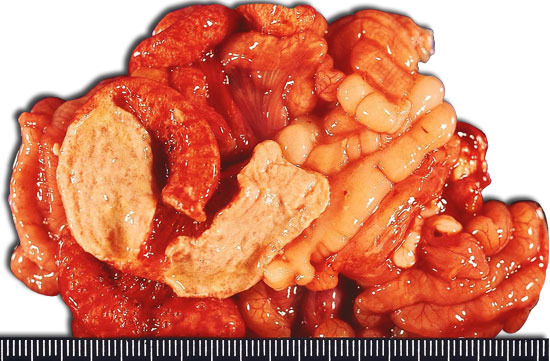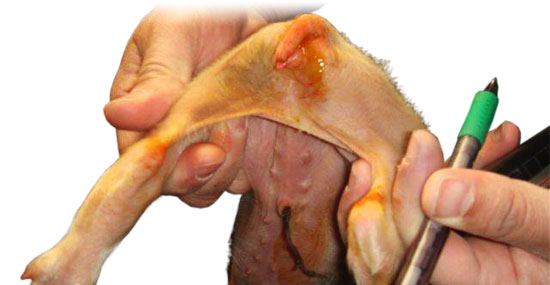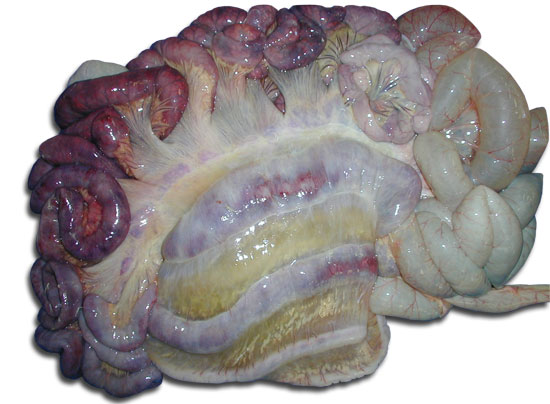The genus Clostridium includes numerous species of anerobic bacteria with large rod-shaped forms, spore makers, and producers of extremely potent and diverse toxins that are almost always responsible for the diseases they cause. That is why vaccines against the illnesses cause by clostridia should contain inactivated toxins against which they want to protect. Fortunately, a large part of these toxins are proteins with a high molecular weight and, therefore, very immunogenic, inducing high levels of antibodies.
It is possible to find distinct species of clostridia forming part of the microbiota of the large intestine of healthy pigs. Although many of these species are pathogenic, in normal conditions they do not spread enough to cause any type of disease.
The pig can have several illnesses caused by more diverse clostridia species, but with piglet diarrhea within the first weeks of life, the following are the main participants:
| Species | Illness |
| Cl. perfingens Type C | Newborn Hemorrhagic Enteritis |
| Cl. perfringens Type A | Necrotic Enteritis |
| Cl. difficile | Neonatal Tyflocolitis |
Newborn hemorragic enteritis
Etiology and pathogenicity
Newborn hemorrhagic enteritis appears, as its name suggests, in the first days of life due to the special pathogeny of the illness.
The causal agent, Clostridium perfringens type C produces mainly one toxin called β toxin, as well as ε toxin. They both have the peculiarity of being sensible to trypsin. For that reason, they only affect newborn piglets that are ingesting colostrum because this colostrum contains trypsin inhibitors, which permit the toxin to remain active in the small intestine of the piglets. In older animals, the β and ε toxins remain active only when their diet contains trypsin inhibitors or in animals that have some kind of pancreatic deficiency.
Epidemiology and pathogenesis
Under normal conditions, the main source of infection in piglets is the feces of sows that contain Cl. perfringens spores that form part of their digestive microbiota.
However, one shouldn’t forget that the characteristics that all clostridia share are their capacity to form spores with enormous resistance to environmental conditions. Therefore, farrowing pens that are not sufficiently disinfected can contain enough spores to infect newborn piglets.
Infection is favored by filth in the farrowing pens, especially dirty sow udders, which favors the piglet getting infected with large quantities of spores upon suckling. The lack of fully developed digestive microbiota in piglets facilitates the massive multiplication of Cl. perfringens in the intestine. However, the disease also appears in modern farrowing pens with no perceptible filth.
Clostridia has a very short generating period and, in adequate conditions, within a few hours can reach 100 to 1.000 million bacteria per gram that adhere to the enterocytes of the tips of the villi, above all in the jejunum, causing the flaking of the enterocytes and the necrosis of villi that give rise to hemorrhages. The necrosis can also reach the crypts, the muscular layer of the mucous and submucous membrane and, sometimes, it can penetrate to the muscular layer of the intestine wall.
Also, a large number of bacteria generate large quantities of β toxin, which is lethal, necrotizing, inflammatory, and increases the permeability of the capillaries.
Death is due to intestinal lesions and the toxemia that gave rise to the illness.
Clinical signs and lesions
The disease usually appears in the first three days of life and normally affects isolated litters, unless the hygienic conditions are very poor. Sometimes, in new farms where the sows are not vaccinated, there are epizootic outbreaks. Once the sows are sufficiently immune after being exposed to infected piglets, the disease appears in its usual form.
The clinical profile is characterized by the fact that in some cases there are hyper acute deaths with no previous clinical signs, although usually a clearly hemorrhagic diarrhea can be observed, staining the perinea area.
The piglets are very weak; they tend to be immobile and easily crushed. The death rate is almost 100% of those affected, in a time period not usually longer than 1-2 days. Before death, sometimes a blackening of the abdominal skin can be seen.
The lesions are striking. There is edema in the abdominal wall and bloody liquid in the abdominal cavity. Upon observing the intestine, one can see intense hemorrhagic enteritis that affects the entire small intestine, mainly the jejunum and the ileum.
In the intestinal wall there are intense hemorrhages and gas bubbles and the mucous membrane has hemorrhagic enteritis that occupies large surface areas of the whole intestine.
In piglets borne of sows with a certain grade of immunity, a subacute form of the illness without diarrhea can appear. In this case, the feces are yellowed and contain necrotic debris. The piglets maintain their appetite and vivacity, but they progressively lose weight and the majority of them die at 5-7 days old. These piglets have a thickened and friable intestinal wall and the mucous membrane is necrotic and much adhered.
In some cases, a chronic form manifests. The affected piglets progressively lose weight and they have intermittent diarrhea with mucous like feces that are yellowed and graying and stain the perineum. The lesions are similar to those of the subacute form, but more localized.


| Cl. perfringens type C: hemorragic enteritis in piglets (Author: Librado Carrasco) | Cl. perfringens type C: hemorragic enteritis in piglets (Author: Quim Segalés) |
Diagnosis
The diagnosis of Cl. perfringens type C enteritis is simple in its acute form. The age of the affected piglets and the clinical signs and lesions are very suggestive. In the subacute and chronic phases, the diagnosis can be more difficult and it is usually necessary to differentiate among other causes of necrotic enteritis, mainly the one caused by Cl. perfringens type A, through isolation and identification in the laboratory.
Treatment and prophylaxis
Treatment for enteritis cause by Cl. perfingens type C is not efficient. In the acute form, mortality is so quick that there is no time to install a treatment, and in the subacute and chronic form, the lesions on the intestinal mucous membrane are very difficult to recuperate from.
This is why the prophylaxis is so important. The hygiene of the farrowing pens is very important, and the cleansing of the sows udders contributes to staving off piglet infection. Lactating sows can be given preventative treatments such as ampicillin or amoxicillin, in order to prevent piglets becoming infected.
These antibiotics, as well as cephalosporins can also be used preventively by administrating them orally to piglets during the first days of life.
However, the most important prophylactic measure, and the most cost effective one, is the vaccination of sows with toxoids. As we indicated, the clostridia toxins are proteins with a high molecular weight and therefore, are good immunogens, and the vaccination of the sows induces antibodies that are transferred to the piglets through the colostrum and provide a high level of protection.
Necrotic enteritis
Necrotic enteritis affects lactating piglets as well as weaned piglets.
Etiology and pathogenesis
Cl perfringens Type A also forms part of the intestinal microbiota of healthy pigs and, therefore, the sows feces are the principal source of infection for the piglets.
The pathogenesis of this illness is not known exactly. Cl perfringens Type A produces the α toxin which is a hemolytic lecithinase and another toxin called β2 has been discovered, that is present in the majority of the swine strains in stick pigs and seems to play a fundamental role in the development of the illness.
The infection, in adequate conditions, provokes a massive multiplication of this clostridia in the ileum, the caecum, and the colon, without any intestinal epithelial adhesion nor invasion.

Clinical signs and lesions
Cl perfringens Type A causes secretion type diarrhea and there are slight atrophy lesions to the villi, necrosis, inflammation of the mucous membrane, and a loss of fluids to the intestinal lumen. The α toxin provokes edemas of the intestinal villi and it is not yet clear what the role of the β2 toxin is, although it is detected in more than 90% of the pathogenic strains.
The clinical signs can manifest within the first days of life in piglets borne to sows that aren’t sufficiently immune. Other times it isn’t see until the end of lactation or even after weaning when maternal immunity is lowered.
The piglets do not look good, with long fur, sunken flanks and a thick yellowish or grey diarrhea that stains the perineum and lasts several days. On occasions, the feces contain mucous and some blood stains, or a reddish color. The death rate is low, but the animals show a considerable delay in recuperation, and often times do not recover fully.
Treatment and prophylaxis
Treatment should be administered as quickly as possible. Traditionally penicillins or derivates have been used. Actually, cephalosporins are greatly effective.
Prophylaxis is more cost effective than treatment. The vaccination of the sows with an adequate vaccine is the best prophylactic measure since it transmits that level of immunity to the lactating piglets.
Neonatal tyflocolitis
Etiology and pathogeny
Clostridium difficile is an important cause of diarrhea associated with humans’use of antibiotics and is being described with more and more frequency as one of the causes of enteritis in newborn piglets.
Cl. difficile is a strict anaerobe, which makes its isolation difficult, producing two toxins called A and B. The A toxin is a high weight enterotoxin and B is a potent cytotoxin.

Clinical signs and lesions
The illness appears mainly in the first week of life in piglets that have received antibiotic treatment as well as those who have not. In the affected litters, the majority of the piglets become infected with a mortality rate that can reach 50%. The clinical profile is characterized by diarrhea that appears within the first days of life, dyspnea, and abdominal distention with scrotal edema.
In the necropsy there is hydrothorax and ascites, edema of the mesocolon and of the colon serosa, and the content of the colon is aqueous and has a yellowish color.

Diagnostic, treatment and prophylaxis
The diagnostic is based on the detection of the A and B toxins in the feces or in the colon content of the piglets.
Tylosin and virginiamycin have been used in the feed of lactating sows as prophylactics. For the treatment of affected piglets, penicillin, tylosin, tilmicosin, tetracyclines, erythromycin and cephalosporins have been used.
There are no available vaccines at this time against Cl. difficile, but other animals’experience with the disease indicates that immunity against the toxins confers protection.
Experimentally, it has been shown that the administration of apathogenic strain spores of Cl. difficile, orally, or indirectly by impregnating the udders of the sows, protects against the disease that causes the pathogenic strains by competitive exclusion.



